 |
APBRmetrics
The statistical revolution will not be televised.
|
| View previous topic :: View next topic |
| Author |
Message |
Ed Küpfer
Joined: 30 Dec 2004
Posts: 785
Location: Toronto
|
 Posted: Fri Jan 28, 2011 3:44 pm Post subject: Scorecasting: The Hidden Influences Behind How Sports Are Pl Posted: Fri Jan 28, 2011 3:44 pm Post subject: Scorecasting: The Hidden Influences Behind How Sports Are Pl |
 |
|
I just got Scorecasting: The Hidden Influences Behind How Sports Are Played and Games Are Won by Tobias Moskowitz and L. Jon Wertheim. I figured I'd blog the basketball content as I read it. But first, the blurbs:
| Quote: | From Booklist
“Defense wins championships!” So declared a triumphant Michael Jordan in 1991, invoking a hallowed sports mantra. But Jordan’s assertion melts into cliché when Moskowitz and Wertheim expose it to statistical calculations revealing that, regardless of the sport, offense proves just as decisive as defense. Indeed, in their wide-ranging iconoclasm, the authors repeatedly poke arithmetic holes in what everyone in sports supposedly knows. Typical is their number-crunching assault on the popular explanation of home-field advantage as a consequence of visiting teams’ road fatigue. Home teams win, the authors demonstrate, chiefly because referees tend to see plays their way—especially when the crowd of spectators grows large. Parsing of data illuminates off-field behavior, too, explaining which athletes use steroids and which ones use marijuana. Even the curse hanging over the Chicago Cubs comes into focus then the analysts ignore the billy-goat myth and statistically assess a management style fostered by fans perversely loyal to “lovable losers”! Sports buffs eager to win their next barroom argument will be lining up for this book. --Bryce Christensen
Review
"The closest thing to Freakonomics I've seen since the original. A rare combination of terrific storytelling and unconventional thinking. I love this book..."
—Steven D. Levitt, Alvin H. Baum Professor of Economics, University of Chicago, and co-author of Freakonomics and SuperFreakonomics
"I love this book. If I told you why, the NBA would fine me again."
—Mark Cuban, owner of the Dallas Mavericks
“Scorecasting is both scholarly and entertaining, a rare double. It gets beyond the cliched narratives and tried-but-not-necessarily-true assumptions to reveal significant and fascinating truths about sports.”
—Bob Costas
"A counterintuitive, innovative, unexpected handbook for sports fans interested in the truths that underpin our favorite games. With their lively minds and prose, Moskowitz and Wertheim will change the way you think about and watch sports. Not just for stats nerds, Scorecasting enlightens and entertains. I wish I had thought of it!"
—Jeremy Schaap, ESPN reporter, Author of Cinderella Man.
"(Sports + numbers) x great writing = winning formula. A must read for all couch analysts."
—Richard Thaler, Professor of Behavioral Science and Economics, best-selling author of Nudge.
“Scorecasting will change the way you watch sports, but don’t start reading it during a game; you’re liable to get lost in it and miss the action. I’m not giving anything away because you’ll want to read exactly how they arrived at their conclusions."--Allen Barra, NJ Star Ledger |
Chapter one, "Whistle swallowing."
Talks about the human tendency to view acts of omission less harshly than acts of commission that result in the same thing. Example: Drowning someone is viewed as worse as watching someone drown and doing nothing to help.
What does this have to do with basketball? The authors (M&W) take on "star calls":
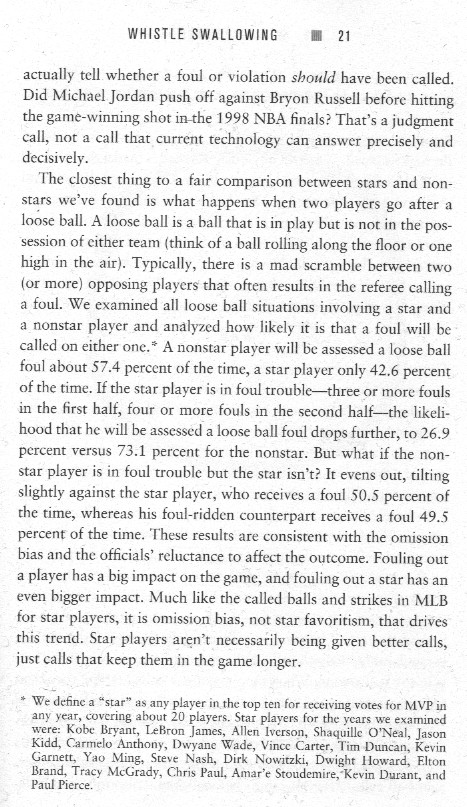
That's kind of a neat experiment, focusing on loose balls. DeanO loves to remind us that it's hard to compare statistics between different circumstances, since not only has the environment changed but also the style of play may also have changed and we don't really account for that (eg home vs away stats). The loose ball idea I think takes most of the "style of play" element out of the equation.
There are no footnotes, but I think the research being discussed is in Daniel Cervone and Tobias Moskowitz's working paper "Whistle Swallowing: Officiating and Omission Bias", which I cannot find online.
_________________
ed
Last edited by Ed Küpfer on Wed Feb 02, 2011 11:46 am; edited 1 time in total |
|
| Back to top |
|
 |
Guy
Joined: 02 May 2007
Posts: 128
|
|
| Back to top |
|
 |
Ed Küpfer
Joined: 30 Dec 2004
Posts: 785
Location: Toronto
|
 Posted: Fri Jan 28, 2011 3:48 pm Post subject: Posted: Fri Jan 28, 2011 3:48 pm Post subject: |
 |
|
Page 24
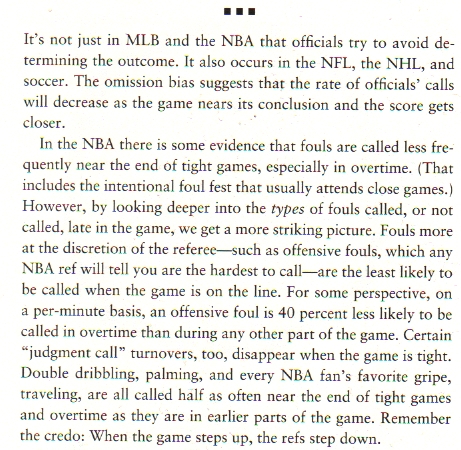
This is the kind of thing DeanO worries about: maybe traveling is called less often at the end of tight games because players play differently, knowing their impact on the game outcome is much higher?
_________________
ed
Last edited by Ed Küpfer on Wed Feb 02, 2011 11:46 am; edited 1 time in total |
|
| Back to top |
|
 |
EvanZ
Joined: 22 Nov 2010
Posts: 269
|
 Posted: Fri Jan 28, 2011 3:51 pm Post subject: Posted: Fri Jan 28, 2011 3:51 pm Post subject: |
 |
|
I suppose one could play devil's advocate and argue that the "star" gets less fouls called because he has more experience and wisdom about how to get loose balls.
I know, I know. Just had to put it out there. 
_________________
http://www.thecity2.com
http://www.ibb.gatech.edu/evan-zamir |
|
| Back to top |
|
 |
Ed Küpfer
Joined: 30 Dec 2004
Posts: 785
Location: Toronto
|
 Posted: Fri Jan 28, 2011 4:51 pm Post subject: Posted: Fri Jan 28, 2011 4:51 pm Post subject: |
 |
|
Pages 28-30 Not basketball, but tennis: M&W discuss the final game of an important match between two players, where one player was called for a foot fault, which pretty much ruined her chances of a comeback. The point M&W are making is that when officials "insert" themselves into a match by making a call that significantly determines the outcome, they risk ostracism. The official in question was indeed ostracized, even though the call was correct.
There is another way to interpret these events: the official was not ostracized for "inserting" herself and determining the outcome, but for calling a rarely-called foul, which seemed entirely arbitrary to the player and fans. My interpretation is that fans and players may not want correct calls so much as consistent calls.
M&W previously discussed the famous "tuck rule" NFL game, aslo interpreting it as suggesting that making an accurate call may be dangerous to the career health of an official. They quote NFL referee Mike Carey:
| Quote: | | Making the hard call, or the unpopular call, that's where guts are tested, that's the mark of a true official. You might have a longer career as an official if you back off. But you won't have a more accurate career. |
I think my alternate interpretation of correct vs consistent calls is equally plausible.
_________________
ed
Last edited by Ed Küpfer on Wed Feb 02, 2011 11:46 am; edited 1 time in total |
|
| Back to top |
|
 |
EvanZ
Joined: 22 Nov 2010
Posts: 269
|
|
| Back to top |
|
 |
Ed Küpfer
Joined: 30 Dec 2004
Posts: 785
Location: Toronto
|
 Posted: Sat Jan 29, 2011 10:02 am Post subject: Posted: Sat Jan 29, 2011 10:02 am Post subject: |
 |
|
Chapter two: Go For It
Long discussion of The Pulaski Academy Bruins football coach, who has an unorthodox offensive philosophy of never punting and always onside kicking. This leads into a discussion of the overly-conservative tactics of most football coaches. Nerd love risky strategies because we think they make sense. Traditionalists don't because they think they make no sense. It's hard for me to make sense of this: the numbers speak for themselves, but the accumulated wisdom of thousands of coaches can't be totally wrong, right? Right? Cynics out there will say "yes of course these coaches can be totally wrong". But I can't make myself believe that. If it's true that conventional wisdom is correct here, then what could we be missing to resolve this?
Pg 43
Does it make sense to take out a player with five fouls with lots of time remaining to save him for the end of the game ? M&W answer "no".
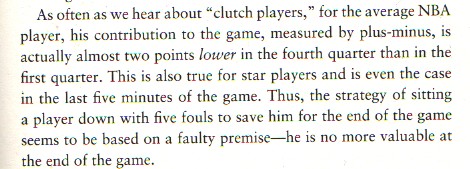
This is not right. Everyone's clutch efficiency is lower than their nonclutch efficiency. They need to compare the star player's efficiency to his replacement's clutch efficiency, not to the star player's nonclutch efficiency.
M&W say
| Quote: | | Leave a player in with five fouls and what happens? The average player with five fouls will pick up his sixth foul and foul out of the game only 21 percent of the time. |
But this merely calls up the DeanO Conundrum: what it the player with five fouls is playing more timidly to avoid that sixth foul? What if this timidity then reduces his efficiency to a level where his replacement then exceeds it?
M&W pin this five-foul strategy on loss aversion, the same thing that makes football coaches punt on 4th and short. I'll accept the probability of an overly conservative 4th down strategy, but I don't think the five-foul strategy is necessarily a mistake.
_________________
ed
Last edited by Ed Küpfer on Wed Feb 02, 2011 11:47 am; edited 1 time in total |
|
| Back to top |
|
 |
Mike G
Joined: 14 Jan 2005
Posts: 3573
Location: Hendersonville, NC
|
 Posted: Sat Jan 29, 2011 10:20 am Post subject: Posted: Sat Jan 29, 2011 10:20 am Post subject: |
 |
|
| Ed Küpfer wrote: |
| Quote: | | Leave a player in with five fouls and what happens? The average player with five fouls will pick up his sixth foul and foul out of the game only 21 percent of the time. |
But this merely calls up the DeanO Conundrum: what it the player with five fouls is playing more timidly to avoid that sixth foul? . |
Is this 21% of the time when a player with 5 fouls is left in the game that he eventually fouls out?
Or is it 21% of all 5th fouls lead to a 6th?
If the latter -- and if such players generally don't stay in the game -- then it hardly makes sense to call this 'what happens' if you leave the player in the game.
_________________
`
36% of all statistics are wrong |
|
| Back to top |
|
 |
Ed Küpfer
Joined: 30 Dec 2004
Posts: 785
Location: Toronto
|
 Posted: Sat Jan 29, 2011 10:47 am Post subject: Posted: Sat Jan 29, 2011 10:47 am Post subject: |
 |
|
| Mike G wrote: | Is this 21% of the time when a player with 5 fouls is left in the game that he eventually fouls out?
Or is it 21% of all 5th fouls lead to a 6th?
If the latter -- and if such players generally don't stay in the game -- then it hardly makes sense to call this 'what happens' if you leave the player in the game. |
I believe they mean the former, but I don't think it's spelled out explicitly. Or perhaps I am misreading the text.
Some data here would be helpful, if any of you PBP wizards are reading this.
_________________
ed |
|
| Back to top |
|
 |
Ed Küpfer
Joined: 30 Dec 2004
Posts: 785
Location: Toronto
|
 Posted: Sat Jan 29, 2011 4:05 pm Post subject: Posted: Sat Jan 29, 2011 4:05 pm Post subject: |
 |
|
pg 47 The case of Bill Belichick. M&W note that the coach who is well known for risky strategies today did not begin his career this way (they contrast the Patriot's 4th down go-for-its versus the Browns from his previous employment). They chalk up this change to Belichick's increasing job security over the years, pointing out that he didn't go for it on 4th downs as often in his early Patriots career as he does today.
It's a neat story. I've heard this explanation before. I wonder if it's true. Are there other coaches who employ more risky strategies as they become more successful? Are there coaches who employ risky strategies who don't have as much job security as a multi Super Bowl winner? Seems that this explanation, if true, should be generalizable.
p55 Belichick is contrasted with Paul Westhead, who tried to install a different kind of risky strategy in Denver with a much less success-filled pedigree. The failure of his experiment is tied by the authors to his players. But that's not the important point the authors want to make: in contrast with Belichick, whose risky strategies were praised,
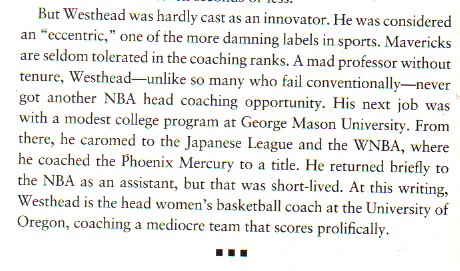
_________________
ed
Last edited by Ed Küpfer on Wed Feb 02, 2011 11:47 am; edited 1 time in total |
|
| Back to top |
|
 |
Jeff Fogle
Joined: 11 Jan 2011
Posts: 62
|
 Posted: Sat Jan 29, 2011 6:21 pm Post subject: Posted: Sat Jan 29, 2011 6:21 pm Post subject: |
 |
|
From the wikipedia entry on Westhead:
"Laker owner Jerry Buss wanted to fire Westhead several days prior to the actual occurrence. The entire Laker team did not get along with Westhead."
Magic Johnson was seen as running Westhead out...just before the Lakers blossomed under Pat Riley. The players apparently backed Magic. Subsequent Westhead NBA records:
28-54 with Chicago in '82-83
20-62 with Denver in '90-91
24-58 with Denver in '91-92
That's 72-174 over three years, AFTER a good group of players ran him off their team. That's not the kind of portfolio that's going to get you hired somewhere else in the NBA. A guy that's hard to get along with who looks to be in over his head at the pro level.
In '93, Westhead went to George Mason, where he was 38-70 over a few seasons. An NBA team is going to hire him away from George Mason while he's compiling a 38-70 college record...after going 44-120 with Denver?
There are other possible descriptions besides calling him an eccentric mad professor without tenure. And, the guy was a head coach at either the NBA or Division I college level through the 80's and most of the 90's.
Anyway, isn't it generally accepted that his style exhausts his own defenses over time because they're the only team playing that pace over the course of a season? It's not one that befuddles or challenges opposing NBA coaches. |
|
| Back to top |
|
 |
Ed Küpfer
Joined: 30 Dec 2004
Posts: 785
Location: Toronto
|
 Posted: Sun Jan 30, 2011 11:49 am Post subject: Posted: Sun Jan 30, 2011 11:49 am Post subject: |
 |
|
p73 A fun example of loss aversion from football:
Scenario 1 - offense starts a series on the opponents one yard line, and now faces fourth and goal after running three straight times and not gaining anything.
Scenario 2 - offense starts on the opponent's ten yard line, gains nine yards on three downs and now faces fourth and goal on the opponents one yard line.
Both teams are 4th and goal from the one yard line. Which scenario is more likely to pass up the FG to go for the TD? The scenario where the team has been stuffed at the goal line three times in a row? Or the scenario where the team has gained three yards per play on the previous three downs? I wouldn't be writing this if it was Scenario 2. The team in scenario 1 has already mentally accounted for the TD because they started the series 1st and goal at the one-yard line, and are scared of losing the TD they thought was "in the bank". The team in scenario 2 had less expectation of a TD, and are more willing to settle for the FG.
Like I said, a fun example. But the difference in go-for-itness doesn't seem that large to me (67% versus 59%). There is no research in the bibliography that seems relevant to this. I'm wondering to what extent this difference is significant, and were other factors accounted for?
_________________
ed
Last edited by Ed Küpfer on Wed Feb 02, 2011 11:47 am; edited 1 time in total |
|
| Back to top |
|
 |
Ed Küpfer
Joined: 30 Dec 2004
Posts: 785
Location: Toronto
|
 Posted: Sun Jan 30, 2011 2:30 pm Post subject: Posted: Sun Jan 30, 2011 2:30 pm Post subject: |
 |
|
p75-6
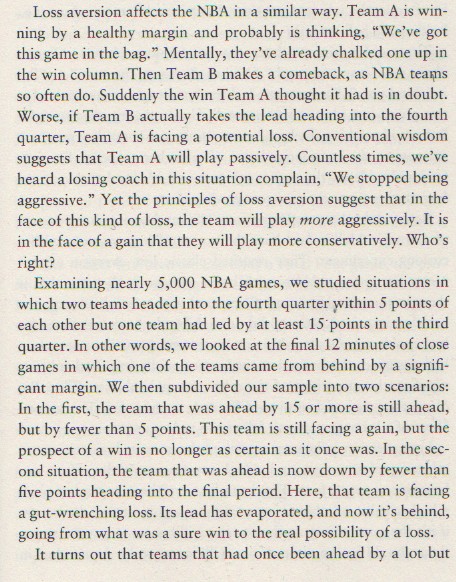
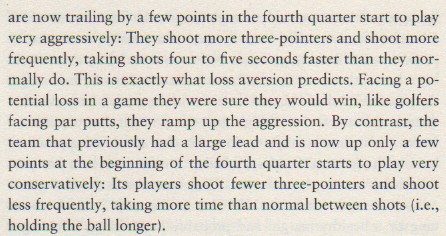
Is shooting more three pointers really an example of playing more aggressively? Haven't we all heard the commentator trope that teams should stop "settling" for jumpers and go strong to the rim? But that's just a minor point. The rest of this looks plausible to me, although again no actual numbers are presented an it doesn't look like any relevant research is listed in the bibliography -- what is the n here? Out of 5000 games, how many meet the conditions of A) <= 5 point score differential at the start of the 4th Q, and B) one team had a >= 15 point lead in the 3rd Q? To what extent is the difference in aggressiveness significant, both in the practical and significant senses?
_________________
ed
Last edited by Ed Küpfer on Wed Feb 02, 2011 11:48 am; edited 1 time in total |
|
| Back to top |
|
 |
Jeff Fogle
Joined: 11 Jan 2011
Posts: 62
|
 Posted: Sun Jan 30, 2011 2:57 pm Post subject: Posted: Sun Jan 30, 2011 2:57 pm Post subject: |
 |
|
Agree with you EK about three-point shooting not representing aggression. I think typically flying at the basket and trying to score or draw a foul is considered being aggressive, while teams who are being passive settle for jumpers (though, I know we've all seen games where teams were aggressively moving the ball around trying to free up a shooter, so the shades of gray are pretty significant).
My issues would be with:
*Conventional wisdom being that teams get passive AFTER blowing a lead. Never heard that. They get passive with a big lead. They blow the big lead. The coach complains after the game that they got passive with the big lead. Not familiar with the concept of teams getting passive AFTER they've blown a lead. Authors said, "Conventional widsom suggests that Team A will play passively" after their lead has already been blown. Disagree with that assessment.
*If you throw out any wild fluctuations that happened earlier in the game, and just start with one team having a lead entering the fourth quarter...isn't it natural for the trailing team to shoot faster and try more threes? They're trailing. Time is running out. Isn't it natural for the team with a lead to treasure their possessions more, hoping to protect their lead as time runs out?
That would seem "normal" for fourth quarters, regardless of what happened earlier. So, the evidence they uncovered in their study might just be a "fourth quarter lead" phenomenon rather than a "what happens after a big lead is erased" phenomenon. I would have preferred they compare their type of fourth quarter with the standard fourth quarter. |
|
| Back to top |
|
 |
EvanZ
Joined: 22 Nov 2010
Posts: 269
|
 Posted: Sun Jan 30, 2011 3:51 pm Post subject: Posted: Sun Jan 30, 2011 3:51 pm Post subject: |
 |
|
As far as the three-pointers go, I would go with DeanO's terminology of "risky" rather than aggressive. I agree that "aggressive" would be driving to the basket, largely with intention of getting fouled.
_________________
http://www.thecity2.com
http://www.ibb.gatech.edu/evan-zamir |
|
| Back to top |
|
 |
|
|
You cannot post new topics in this forum
You cannot reply to topics in this forum
You cannot edit your posts in this forum
You cannot delete your posts in this forum
You cannot vote in polls in this forum
|
Powered by phpBB © 2001, 2005 phpBB Group
|